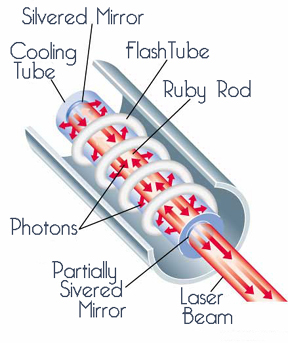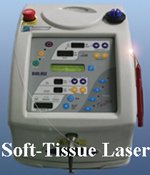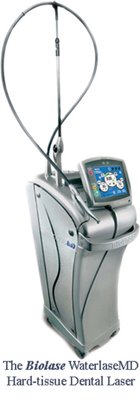Dental Lasers Explained
On this page, "Dental Lasers Explained," we will try to define not only dental lasers, but lasers in general. Lasers are an important part of many medical procedures that are now performed, and they are slowly gaining acceptance in the dental field. But what exactly is a laser, and how can it be utilized in dental treatments? First, it's important to understand what a laser is. The word "LASER" is an acronym for Light Amplification by Stimulated Emission of Radiation. As quoted from the PCMag.com Encyclopedia, a laser is: "A device that creates a uniform and coherent light that is very different from an ordinary light bulb. Many lasers deliver light in an almost-perfectly parallel beam (collimated) that is very pure, approaching a single wavelength. Laser light can be focused down to a tiny spot as small as a single wavelength. Laser output can be continuous or pulsed and is used in a myriad of applications.  A laser is an optical oscillator, which is made out of a solid, liquid or gas with mirrors at both ends. To make the laser work, the material is excited or 'pumped,' with light or electricity. The pumping excites the electrons in the atoms, causing them to jump to higher orbits, creating a 'population inversion.' A few of the electrons drop back to lower energy levels spontaneously, releasing a photon (quantum of light). The photons stimulate other excited electrons to emit more photons with the same energy and thus the same wavelength as the original. The light waves build in strength as they pass through the laser medium, and the mirrors at both ends keep reflecting the light back and forth creating a chain reaction and causing the laser to 'lase.'" A laser is an optical oscillator, which is made out of a solid, liquid or gas with mirrors at both ends. To make the laser work, the material is excited or 'pumped,' with light or electricity. The pumping excites the electrons in the atoms, causing them to jump to higher orbits, creating a 'population inversion.' A few of the electrons drop back to lower energy levels spontaneously, releasing a photon (quantum of light). The photons stimulate other excited electrons to emit more photons with the same energy and thus the same wavelength as the original. The light waves build in strength as they pass through the laser medium, and the mirrors at both ends keep reflecting the light back and forth creating a chain reaction and causing the laser to 'lase.'"
Simply put, a laser is an energized beam of pure, monochrome light that can be safely and effectively used with pinpoint accuracy in a variety of applications, including surgery and dental treatments. Dental Applications for Lasers dental lasers explainedDental lasers can be precisely controlled, and, in the trained hands of an experienced laser dental practitioner, can be a very patient-friendly and effective way to perform many dental procedures.dental lasers explained
Low-intensity, "soft-tissue" dental lasers can be used to detect tooth decay in its very early stages, by giving accurate readings of decay by-products.  Soft-tissue lasers are also great for various treatments of the gum tissue, such as reshaping, removing benign oral tumors, and aiding in the healing of cold sores. Through a process known as "Photobiomodulation," they can stimulate the regeneration of damaged nerves and blood vessels. The benefits of the laser in these applications are that the high-energy light beam sterilizes the area being worked on, and also causes quick coagulation of exposed blood vessels, thus minimizing blood loss. As a result, the treated areas may heal more quickly and have less pain.dental lasers explained Soft-tissue lasers are also great for various treatments of the gum tissue, such as reshaping, removing benign oral tumors, and aiding in the healing of cold sores. Through a process known as "Photobiomodulation," they can stimulate the regeneration of damaged nerves and blood vessels. The benefits of the laser in these applications are that the high-energy light beam sterilizes the area being worked on, and also causes quick coagulation of exposed blood vessels, thus minimizing blood loss. As a result, the treated areas may heal more quickly and have less pain.dental lasers explained
Soft-tissue lasers are also used in dental hygiene cleanings and to improve and speed up teeth whitening procedures.
 High-intensity, hard-tissue lasers are used to prepare teeth for fillings, and may eliminate the need for the standard turbine drill, and local anesthetic injections (if the cavity is not too close to the nerve). It also has the ability to disinfect the area being worked on, and seal open dentin tubules (the tiny tubes that go from the tooth nerve or pulp to the outer enamel of the tooth) to help eliminate sensitivity to cold or hot foods or liquids. High-intensity, hard-tissue lasers are used to prepare teeth for fillings, and may eliminate the need for the standard turbine drill, and local anesthetic injections (if the cavity is not too close to the nerve). It also has the ability to disinfect the area being worked on, and seal open dentin tubules (the tiny tubes that go from the tooth nerve or pulp to the outer enamel of the tooth) to help eliminate sensitivity to cold or hot foods or liquids.
After a tooth cavity has been cleaned out and disinfected by the laser, and a biocompatible, "tooth-like" filling material is injected into the treated area, a "bonding" laser can be used to fuse, or bond the filling material to the tooth, returning the tooth to its original strength and appearance. In oral surgery applications, the hard-tissue, as well as the soft tissue lasers can be used in procedures that normally would require cutting with scalpels or blades, and due to their self-cauterizing nature, may many times eliminate the need for stitches or sutures, and help speed up the healing process.
Another big benefit of dental lasers is that they are much more benign to the patient than the standard dental tools, such as scrapers, drills, and blades. This can help to greatly reduce patient fear and anxiety, and may encourage the patient to make return visits for additional needed treatment.
Top of Page
Return from "Dental Lasers Explained" to Home Page
|
 A laser is an optical oscillator, which is made out of a solid, liquid or gas with mirrors at both ends. To make the laser work, the material is excited or 'pumped,' with light or electricity. The pumping excites the electrons in the atoms, causing them to jump to higher orbits, creating a 'population inversion.' A few of the electrons drop back to lower energy levels spontaneously, releasing a photon (quantum of light). The photons stimulate other excited electrons to emit more photons with the same energy and thus the same wavelength as the original. The light waves build in strength as they pass through the laser medium, and the mirrors at both ends keep reflecting the light back and forth creating a chain reaction and causing the laser to 'lase.'"
A laser is an optical oscillator, which is made out of a solid, liquid or gas with mirrors at both ends. To make the laser work, the material is excited or 'pumped,' with light or electricity. The pumping excites the electrons in the atoms, causing them to jump to higher orbits, creating a 'population inversion.' A few of the electrons drop back to lower energy levels spontaneously, releasing a photon (quantum of light). The photons stimulate other excited electrons to emit more photons with the same energy and thus the same wavelength as the original. The light waves build in strength as they pass through the laser medium, and the mirrors at both ends keep reflecting the light back and forth creating a chain reaction and causing the laser to 'lase.'" Soft-tissue lasers are also great for various treatments of the gum tissue, such as reshaping, removing benign oral tumors, and aiding in the healing of cold sores. Through a process known as "Photobiomodulation," they can stimulate the regeneration of damaged nerves and blood vessels. The benefits of the laser in these applications are that the high-energy light beam sterilizes the area being worked on, and also causes quick coagulation of exposed blood vessels, thus minimizing blood loss. As a result, the treated areas may heal more quickly and have less pain.dental lasers explained
Soft-tissue lasers are also great for various treatments of the gum tissue, such as reshaping, removing benign oral tumors, and aiding in the healing of cold sores. Through a process known as "Photobiomodulation," they can stimulate the regeneration of damaged nerves and blood vessels. The benefits of the laser in these applications are that the high-energy light beam sterilizes the area being worked on, and also causes quick coagulation of exposed blood vessels, thus minimizing blood loss. As a result, the treated areas may heal more quickly and have less pain.dental lasers explained High-intensity, hard-tissue lasers are used to prepare teeth for fillings, and may eliminate the need for the standard turbine drill, and local anesthetic injections (if the cavity is not too close to the nerve). It also has the ability to disinfect the area being worked on, and seal open dentin tubules (the tiny tubes that go from the tooth nerve or pulp to the outer enamel of the tooth) to help eliminate sensitivity to cold or hot foods or liquids.
High-intensity, hard-tissue lasers are used to prepare teeth for fillings, and may eliminate the need for the standard turbine drill, and local anesthetic injections (if the cavity is not too close to the nerve). It also has the ability to disinfect the area being worked on, and seal open dentin tubules (the tiny tubes that go from the tooth nerve or pulp to the outer enamel of the tooth) to help eliminate sensitivity to cold or hot foods or liquids.